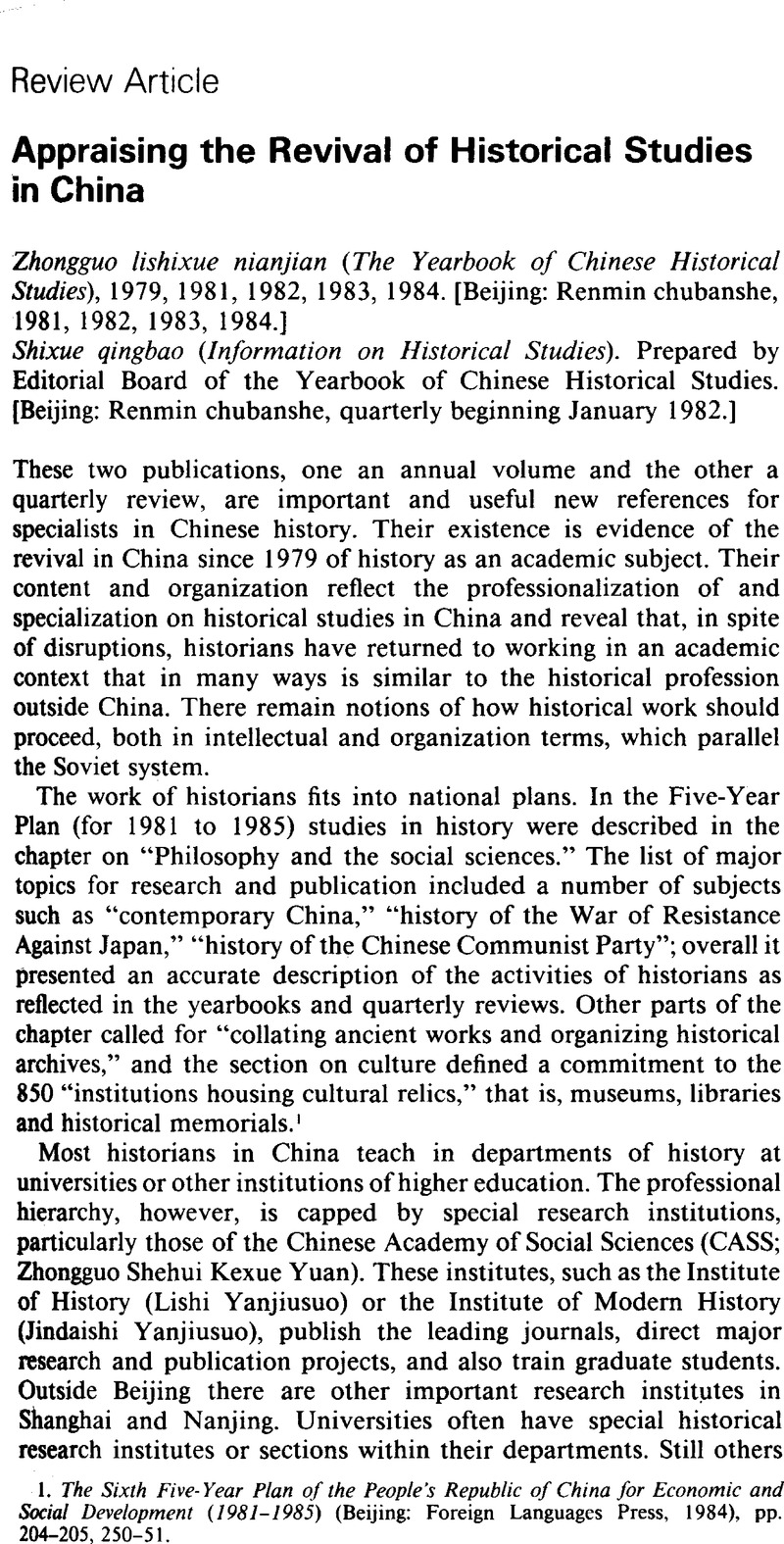No CrossRef data available.
Published online by Cambridge University Press: 17 February 2009

1. The Sixth Five-Year Plan of the People's Republic of China for Economic and Social Development (1981–1985) (Beijing: Foreign Languages Press, 1984), pp. 204–205, 250–51Google Scholar.
2. Descriptions of these individual institutes can be found in the yearbooks. The 1979 Yearbook began with information about those in Beijing, Tianjin and Shanghai. Subsequent volumes have surveyed those of the various provinces. There are also tables which give brief listings of historical associations, research groups, departments of history and names of specialized research institutes.
3. Feuerwerker, Albert (ed.), Chinese Studies of Modern Chinese History (Cambridge: Harvard University Press, 1961)CrossRefGoogle Scholar. Wakeman, Frederic (ed.), Ming and Qing Historical Studies in the People's Republic of China (Berkeley: Institute of East Asian Studies, 1980)Google Scholar. Feuerwerker, Albert (ed.), Chinese Social and Economic History from the Song to 1900: Report of the American Delegation to a Sino-American Symposium in Beijing, 1980 (Ann Arbor: Center for Chinese Studies, 1982)Google Scholar.
4. Some sections of the yearbooks are being translated into English. Late Imperial China (formerly Ch'ing-shih wen-t'i), Vol. VI, No. 1 (06 1985), pp. 113–22Google Scholarincludes a translation of Zhang Kaiyuan and Liu Wanglin's article on the study of the 1911 Revolution from the 1983 yearbook. Additional translations are to be done under the direction of Mi Chu Wiens of the Library of Congress.
5. The CHA was founded in 1951 with Guo Morou as chairman, but it collapsed with other academic associations during the Cultural Revolution. After three preparatory meetings the CHA was reconstituted in April 1980 at meetings held in Beijing. Zhongguo lishixue nianjian, 1979 (hereafter Nianjian), pp. 247–48; Nianjian 1981, pp. 361–63.
6. Nianjian, 1983, pp. 388–90, 398–400.
7. Some helpful pieces also are to be found in Shixue qingbao. Chen Xingtang contributed two pieces describing the contents of China's No. 2 Historical Archive in Nanjing, which is the primary repository in the People's Republic for records of the Republic of China's government, 1927–1949. 1983, No. 1, pp. 85–87; 1983, No. 2, pp. 104–105.
8. Mi Rucheng wrote about three books and 100 articles in the revived field of modern economic history and organized the main lines of inquiry into six topics: (1) the economic aggression of foreign capitalism; (2) the development and character of China's bourgeoisie and national capitalists; (3) problems of the agricultural economy; (4) economic construction in Chinese Communist base areas; (5) economic conditions under Japanese occupation; and (6) the rise and fall of urban centres. The last three are new topics of historical research, Nianjian, 1982, pp. 183–92. Mi Rucheng also contributed the survey for this field in 1984. See Nianjian, 1984, pp. 190–99.
9. Nianjian, 1983, pp. 155–60.
10. “Jianguo yilai Zhongguo jindaishi wenti taolun jianjie,” Nianjian, 1983, pp. 643–742.
11. The three top historical journals are Lishi yanjiu (Historical Studies), edited by Li Shu of the CASS Institue of History; Zhongguoshi yanjiu (Studies in Chinese History) also edited at the Institute of History; and Jindaishi yanjiu (Studies in Modern History) edited at the Institute of Modern History. The last two journals began publication only in 1979. The People's Republic's oldest historical journal is Lishi jiaoxue (Teaching History) which began publication in 1951. There are many other specialized history journals and various annual bulletins which have begun or resumed publication in recent years.
12. “Guanyu shixue yanjiu gongzuo gaige de yidian xiangfa” (“Some thoughts about the reform of historical research”), Guangming ribao (Guangming Daily), 15 May 1985.
13. Ibid.
14. Nianjian, 1984, pp. 4–5.
15. Nianjian, 1984, pp. 7–18.
16. “Shi yu lun,” Lishi yanjiu, No. 4, (1984), pp. 3–6Google Scholar.
17. Ibid. p. 3.
18. “Buneng lanyong ‘jiashe,’” Guangming ribao, 3 April 1985.
19. “‘Gengxin’ shixue zhishi de tifa bushuo” (“The method of ‘reforming’ history won't work”), Guangming ribao, 17 April 1985.
20. “Guanyu lishi yanjiu de mudi he renwu” (“On the goals and responsibilities of historical research”), Guangming ribao, 17 April 1985.
21. In particular see “Guonei shixuejie guanyu jindai Zhongguo zichang jieji de yanjiu” (“Chinese historians' studies of the modern Chinese bourgeoisie”), Lishi yanjiu, No. 4 (1983), pp. 55–66Google Scholarand Liqiang, Yang and Weiben, Shen, “Jindai Zhongguo zichan jieji yanjiu taolunhui congshu” (“Symposium on the study of the modern Chinese bourgeoisie”), Lishi yanjiu, No. 6 (1983), pp. 148–56Google Scholar. Also see a special issue of Wenshizhe (Literature, History and Philosophy) on the question of the main current in Modern Chinese history, No. 3 (1983)Google Scholar.
22. Shiyue, Li, “Zhongguo jindaishi zhuyao xiansuo jiqui biaozhi zhi wojian” (“My views on the mainstream of modern Chinese history and its characteristics”), Lishi yanjiu, No. 2 (1984), pp. 122–32Google Scholar.
23. “Zhongguo jindaishi de ‘liangge guocheng'ji youguan wenti” (“The ‘two courses’ in modern Chinese history and related questions”), Lishi yanjiu, No. 4 (1984), p. 13Google Scholar.
24. Xi, Wang, “Du Jidaishi sibianlu” (“A review of Speculations on Modern History”), Renmin ribao (People's Daily), 10 05 1985Google Scholar.
25. Nianjian, 1983, pp. 338–39.